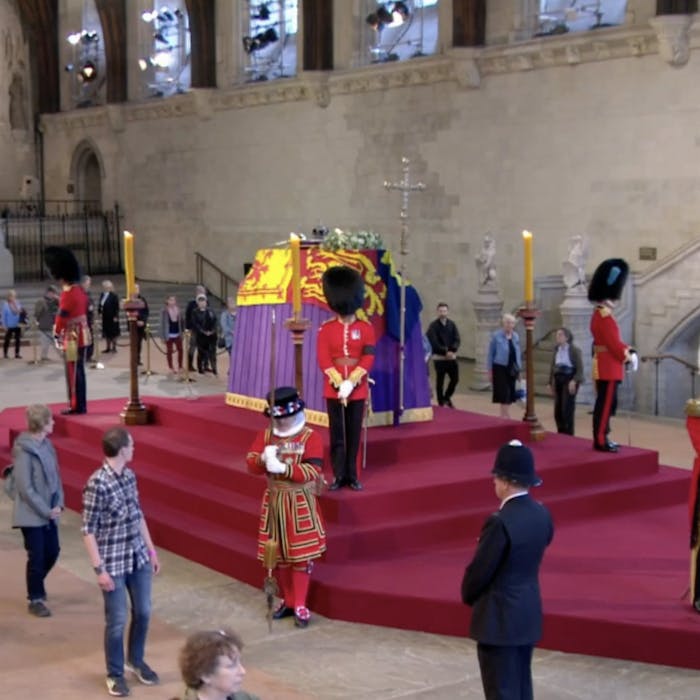
Westminster Hall- a dramatic national ceremonial space , steeped in significance
Nearly a thousand years old, the massive, imposing and dramatic Westminster Hall, is the oldest surviving part of the Palace of Westminster and scene of many significant events in British history. When erected in 1097 by King William II ('William Rufus'), it was the largest hall in Europe.
The roof was probably originally supported by pillars, creating a long space made up of three aisles, but during the reign of King Richard II, this was replaced by a hammerbeam clearspace roof by the royal carpenter Hugh Herland, as the greatest creation of medieval timber architecture, above a single huge open space 68 by 240 ft with a dais at the end.
The new roof was commissioned in 1393 and Richard's master builder Henry Yevele also refaced the walls, with fifteen life-size statues of kings placed in niches. The favourite heraldic badge of Richard II – a white hart, chained, and in an attitude of rest – is repeated eighty-three times around the space, without any of them being an exact copy of another.
Oak timbers for the roof came from royal woods in Hampshire and from parks in Hertfordshire and Surrey, delivered by wagons and barges to Westminster for assembly.
Until the 19th century, the Hall was regularly used for judicial purposes, housing three of the most important courts in the land: the Court of King's Bench, the Court of Common Pleas and the Court of Chancery.
In 1215, Magna Carta stipulated that these courts would sit regularly in the Hall for the convenience of litigants.
In 1875, the courts were amalgamated into the High Court of Justice, which continued to have chambers adjacent to Westminster Hall until moved to the new Royal Courts of Justice building in 1882. Westminster Hall also housed important state trials, including the state trials of King Charles I at the end of the English Civil War, William Wallace, Thomas More, Cardinal John Fisher, Guy Fawkes, the Earl of Strafford, the rebel Scottish lords of the 1715 and 1745 uprisings, and Warren Hastings.
The St Stephen's Porch end of the Hall displays under the stained glass window the names of Members and staff of both Houses of Parliament killed serving in the First World War. The window itself, installed in 1952, commemorates those members and staff who died in the Second World War. In 2012, a new stained glass window commemorating Queen Elizabeth II's diamond jubilee was installed opposite this window, at the other end of the hall.
Ceremonial functions since the twelfth century have included coronation banquets honouring new monarchs and a place for lying in state during state and ceremonial funerals. Most recent have been Winston Churchill (1965), Queen Elizabeth The Queen Mother in 2002, and Queen Elizabeth II in 2022.
The two Houses of Parliament have come together to present ceremonial Addresses to the Crown in Westminster Hall on important public occasions, such as Queen Elizabeth II's Silver (1977), Golden (2002) and Diamond Jubilees (2012), and the Accession of Charles III (2022),
Distinguished Foreign leaders have also been invited to address both Houses of Parliament in Westminster Hall. Since the Second World War, this honour has only been extended to French president Charles de Gaulle in 1960, South African president Nelson Mandela in 1996, Pope Benedict XVI in 2010, U.S. president Barack Obama in 2011 and Burmese opposition leader Aung San Suu Kyi in 2012.
Since 1999, the House of Commons now uses the Grand Committee Room next to Westminster Hall as an additional debating chamber. In contrast with the two main Chambers, in which the government and opposition benches directly face each other, the seating in the Grand Committee Room is laid out in a U-shape, a pattern meant to reflect the non-partisan nature of the debates there.
Further reading
Links to external websites are not maintained by Bite Sized Britain. They are provided to give users access to additional information. Bite Sized Britain is not responsible for the content of these external websites.
